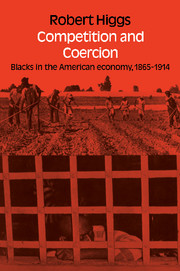Book contents
- Frontmatter
- Contents
- List of tables
- Preface
- “Race” and “racial discrimination”: A prefatory note on usage
- 1 Approaching the facts
- 2 The people
- 3 The people at work, 1865–1880
- 4 The people at work, 1880–1914
- 5 The fruits of their labors
- 6 Overview and interpretation
- Technical appendix
- Notes
- Select bibliography
- Index
“Race” and “racial discrimination”: A prefatory note on usage
Published online by Cambridge University Press: 07 October 2011
- Frontmatter
- Contents
- List of tables
- Preface
- “Race” and “racial discrimination”: A prefatory note on usage
- 1 Approaching the facts
- 2 The people
- 3 The people at work, 1865–1880
- 4 The people at work, 1880–1914
- 5 The fruits of their labors
- 6 Overview and interpretation
- Technical appendix
- Notes
- Select bibliography
- Index
Summary
This book deals with the economic history of the “black race” in the United States from 1865 to 1914. What defined this group? Evidently the persons who constituted it were not all literally black; in fact their skin color ranged from black through various shades of brown to red, yellow, and even white. Moreover, any claim that they belonged to a biologically unique class has, in the judgment of modern scientists, a questionable validity at best. Current scientific interpretations maintain “that races are neither discrete nor stable units but rather that they are plastic, changing, integral parts of a whole which is itself changing… [and] that racial differences involve the relative frequency of genes and characteristics rather than absolute and mutually exclusive distinctions.” All these facts are interesting, and no doubt important for some purposes, but they have little bearing on the present study. For the “blacks” of the post-Civil War era were culturally defined as those persons believed to possess some African ancestry, no matter how remote. More concretely, as W. E. B. Du Bois expressed it back in the days of segregated railway cars, “the black man is a person who must ride ‘Jim Crow’ in Georgia.” Contemporaries had little difficulty with the concept of race, and all but lunatics and small children satisfactorily distinguished the “blacks” from the “whites.” The present study follows their own usage. To do otherwise would create burdensome and un-necessary expositional problems.
- Type
- Chapter
- Information
- Competition and CoercionBlacks in the American economy 1865-1914, pp. 1 - 2Publisher: Cambridge University PressPrint publication year: 1977



